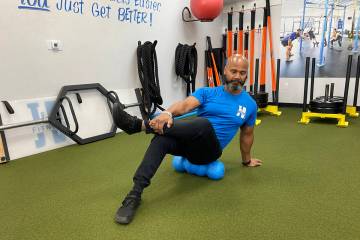Calcium is necessary, but tricky to take
Better make sure you’re getting enough calcium, or your bones may suffer for it.
Lack of calcium can contribute to osteoporosis, which can lead to bone injuries that can be debilitating, especially in older people. But calcium serves other functions in the body.
“A lot of people associate calcium with bone health, and 99 percent of it is stored in your bones,” said Damon McCune, a registered dietitian and coordinator of the UNLV Nutrition Center.
But the other 1 percent, McCune said, is found in the serum in the blood, where it’s responsible for vital bodily functions such as sending electrical impulses to the nerves. And because your body needs it for the blood, it’ll draw it from your bones if you’re not getting enough.
Calcium also can play a big role in controlling blood pressure and reducing hypertension, he added.
So how much do you need? For the average healthy adult, about 1,000 milligrams a day. Children ages 9 through 18 need about 1,300 milligrams a day, while those 19 to 50 need about 1,000 milligrams. From ages 51 to 70 the recommended dietary allowance is 1,000 milligrams for men and 1,200 for women, and 1,200 milligrams for both after age 71.
The best sources, as you might suspect, are in dairy products such as milk, yogurt and cheese. Eight ounces of low-fat plain yogurt provides about 415 milligrams on average, McCune said.
“Typically, if you start adding fruit to that yogurt, they aren’t able to put as much yogurt in there, so that will reduce the amount of calcium” by about 1,000 milligrams, he said.
If you’re drinking milk, dietitians recommend fat content of 2 percent or less. The only differences in the various forms of milk, McCune said, are in the fat; other nutrients, including calcium, remain about the same.
Those who are lactose-intolerant or avoid dairy for other reasons can get calcium from firm tofu, which contains about 250 milligrams in a half-cup; raw kale, about 100 milligrams in a cup; or other green, leafy vegetables. Nondairy milks such as almond and soy are only good sources if they’re labeled “calcium-fortified,” McCune said.
But when it comes to calcium consumption, it seems there are caveats flying all over the place. For example, your body won’t use it efficiently if you’re not getting enough vitamin D.
“Some vitamin D does seem to enhance the absorption a little bit,” McCune said. “It will also help in the long run. Lack of vitamin D could add to an accelerated breakdown of bone. That’s why there’s such big attention around vitamin D lately, because we’re learning that it’s doing a lot more than we thought it was.”
Sources for vitamin D include fortified milk — and the sun.
“Luckily, we’re in the desert,” McCune said, adding that research has shown that sufficient levels of vitamin D may be synthesized simply by spending 15 to 20 minutes outdoors, wearing a T-shirt, two to three times a week.
“This is where there’s a lot of debate in the industry,” he said. “It hasn’t really been narrowed down. But there’s a very easy test that people can ask for from their doctors.”
But back to those caveats. Another is that no matter how much calcium you consume, through either dietary or supplemental sources, your body can absorb only about 500 milligrams at one sitting.
“And that’s in a perfect world,” McCune said. “Most people aren’t quite that efficient.” If you’re taking a supplement, he said, it doesn’t matter if it’s 1,000 milligrams, because you won’t absorb more than 500 milligrams at once. And caffeine, diuretics and antacids can all decrease absorption of calcium.
You also don’t want to get too much of a good thing.
“Enough calcium and vitamin D can be really good,” McCune said, “but too much can be bad.”
Indeed, according to the Cleveland Clinic, excessive consumption of calcium can lead to higher risk for heart disease and stroke, because without enough vitamin D to help the body absorb it, it can settle in the arteries and contribute to the formation of plaque.
McCune said it’s important, when considering supplements, to remember how much you’re getting from dietary sources.
“A lot of times when people are supplementing, they don’t take into account the amount from the food they’re eating,” he said. “That can lead to kidney stones and other problems.”
Also, he said, it’s important to engage in some sort of weight-bearing activity, along with cardio work.
“For bone health, you need something like lifting weights or running,” he said, “anything that’s got some impact.”
Contact reporter Heidi Knapp Rinella at hrinella@reviewjournal.com or 702-383-0474.




























